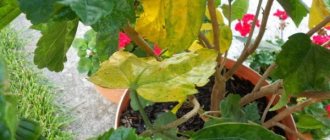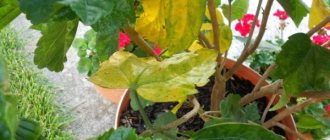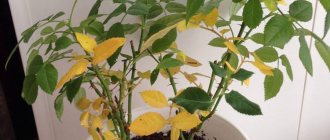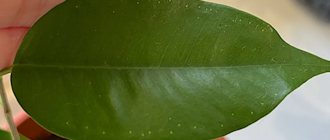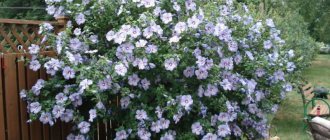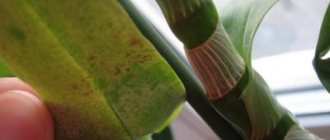Hibiscus is a capricious plant; it must be cared for strictly according to certain rules. Indeed, with the slightest change in favorable conditions, the Chinese rose responds with the loss of its decorative qualities. Then suddenly the leaves begin to turn yellow, and then real leaf fall occurs. There is definitely an explanation for this behavior of an indoor flower. It is possible that this is due to disease or pests, or maybe the hibiscus is under stress. It is important for the gardener to quickly establish why the hibiscus leaves turn yellow, the cause of the negative changes, and take urgent measures to save the plant.
The main causes of yellow leaves and their elimination
It is impossible to say with certainty the reason for the loss of an attractive plant appearance without analyzing many factors. A thorough examination and analysis of all parts of the plant, soil, location of the bush, and recent conditions will help to find out why the leaves turn yellow. We will look at the most common reasons.
Watering
Hibiscus is a tropical plant that requires a lot of moisture only in the hot season. During the cold season, water stagnates if you water too often. Because of this, the root system begins to rot, growth stops, and leaves fly off due to lack of nutrients.
Insufficient watering
In high temperatures, hibiscus require a lot of water, sometimes even twice daily watering if the weather is really hot or windy. Drip irrigation systems can be a great way to keep your plant from going dry.
Abundant watering
Hibiscus can suffer from excess water, especially during dark and cool seasons. They like moist soil, but cannot tolerate "swamp", or cold, wet, heavy soil. Therefore, excessive watering also causes stress in the root system, which affects the plant as a whole.
Air temperature
Hibiscus is a tropical plant, so it prefers high temperatures. Optimal conditions +20, +25°С. In the summer, with the onset of heat above +30° C, the bush will shed some of its leaves to avoid strong evaporation of moisture. In winter, the plant will withstand +16, +18° C, but if the pot is placed on a window, the cold glass will cause yellowing of the leaves closest to it. Hibiscus will not die even at +12, +14° C, but will shed its leaves in the fall in order to survive in a cool room and save vital energy.
If they are too cold or standing close to cold glass, the reaction will be yellowing of the leaves.
Exposure to sunlight
Hibiscus is undemanding to lighting conditions. But direct sunlight will cause burns on the leaves, which will turn yellow and fall off. The flower will also respond to a lack of light and being in the shade by shedding its foliage - this will help it save energy for further development. In spring, the flower can be moved to a lighted windowsill, closer to the light. In winter, provide sufficient artificial light.
The optimal solution would be to place young plants on western or eastern windows. Diffused light will ensure the normal condition of the leaves, but there will be no flowering if there is not enough sun. An adult bush is placed near southern windows to stimulate the appearance of flowers. In summer, hibiscus feels good on the balcony and in the garden, if it is not exposed to the sun.
Abundant sunshine
Hibiscus love sunlight, but like most people, they prefer a moderate amount. Too much sun stresses hibiscus plants and they react by yellowing the leaves or developing large white spots (sunburn) on the leaves. Too much sun will not kill the plant, but it will cause yellowing and loss of leaves.
A small amount of light
Light is the source of life for plants like hibiscus. If they don't get enough light to support their large shiny leaves, they will drop them, as the fewer leaves there are, the less light the plant needs to survive. However, this means that the amount of chlorophyll needed to support the entire plant is reduced, so the shedding process will continue until only a few leaves remain.
Draft
Hibiscus does not tolerate drafts. Constant movement of air, especially cold air, from an open window in winter, will destroy the plant. When ventilating the room, the pot is removed from the windowsill, since gusts of wind dry the surface of the leaves in the heat, and in winter they are strongly cooled with icy air.
Dry air is a common cause of leaves turning yellow and falling. In the tropics, in the plant’s homeland, high atmospheric humidity is the norm. Therefore, at home it is important to maintain a microclimate that is comfortable for indoor hibiscus.
Dry air is eliminated by placing trays with wet expanded clay near heating radiators and hanging wet towels on radiators. Regular warm showers in the summer will replenish moisture loss and will be a good prevention of parasites. Daily spraying of the leaves of the plant is an essential part of caring for the shrub.
Potty doesn't fit
In order for the plant to actively grow and delight with lush and bright flowering, you need to take care of a comfortable and spacious pot. If the hibiscus is crowded in a flowerpot, then its leaves begin to turn yellow, wither and fall off. The same thing happens with the branches - they wither.
To prevent yellowing of the leaves, it is necessary to plant the plant in a large pot in which its root system will feel free. It is important to remember that hibiscus does not like frequent transplants, in order to injure the plant less, it must be transferred to a new, larger container along with a lump of earth.
Diseases and pests
Buying new flowers in a store, or placing plants on a balcony or in a garden in the summer often leads to the appearance of pests and infectious diseases.
Insects, spider mites
Spider mites are small mites that look like crabs under a magnifying glass. They are usually not visible to the naked eye, but they leave marks on the leaves of hibiscus trees. First, spots appear on the leaves, which look dirty and withered. On the reverse side of the leaf there are traces of mites sucking out the juice. And finally, a thin web becomes visible between the leaves and at the top of the stem. The leaves will turn yellow and fall off, and the entire plant will look unhealthy.
If no action is taken, spider mites can damage all the leaves and the plant will be completely “bald”.
The plant will take weeks to recover, so it is better to take action before such dire consequences occur. Use the drug "Actellik" to combat spider mites on indoor plants; spraying with soapy water (laundry soap) 2-3 times a day also gives good results.
Shchitovka
The harmful effect of the parasite is aimed at the leaves of the plant. Insects feed on the pulp and juice of the leaves, thereby causing them to turn yellow and subsequently fall off. Measures to combat scale insects: treating the flower with Actellik.
Aphid
A common type of pest of indoor plants. Aphids, laying their larvae in the leaves of a plant, cause significant harm to it. The voracious larvae feed on the juice and pulp of the leaves, all of which provokes yellowing and falling off of the affected flower structures. A distinctive sign of aphid pests is the curling of the affected leaves. Measures to combat aphids: spraying the plant with Fitoverm.
Other pests:
- Gall midge - Midge larvae eat away the contents of buds and unopened leaves. It is recommended to collect and destroy damaged buds and leaves, and disinfect the soil.
- Greenhouse whitefly - Damages leaves and causes yellowing. Treatment is carried out with a solution of potassium soap. Preparations - Karbofos, Aktara, Zubr.
- Scale insects - They settle in the axils of leaves, sucking out the juices. Treatment with mineral oil and alcohol solution is recommended. Preparations Confidor, Aktara.
Excess or lack of fertilizers
With frequent fertilization of the soil, the plant’s body experiences stress, something like an excess of sugar in a person’s blood, and reacts to this with yellowing leaves. We can help hibiscus cope with this. When fertilizing the soil of indoor flowers, you need to know exactly the dosage and type of substances they feed on.
- In winter, organic preparations are added - Humisol, Vermisol (2% solution).
- Non-infectious chlorosis - lack of nutrition is treated by watering and spraying with Ferovit solution (1.5 ml per 2 liters of water).
Important! Fertilize an indoor flower during the period of active growth, respectively, in the spring and summer. In winter, the plant must rest, so fertilizing the soil is stopped. The ideal fertilizer option for Chinese roses are formulations marked “For non-flowering indoor plants.”
Incorrect acidity - chlorosis
There are several conditions called chlorosis - the yellow color of the leaves in case of this lesion can vary greatly. The castings will remain partially green and yellow in the part where chlorosis develops. Then the leaves turn completely yellow and fall off. You can save an indoor flower by replanting it in a new soil mixture and adding fertilizers containing iron.
If they do not turn yellow completely and remain on the plant, this indicates a lack of certain nutrients. This can happen due to a lack of fertilizer, or due to the incorrect acidity of the soil becoming too acidic or too alkaline. In this case, the leaves do not turn bright yellow and do not fall off. This problem can be corrected by applying fertilizer and/or adjusting the acidity of the soil.
At home, the soil often becomes alkalized due to too hard water.
Use of pesticides
This is not the most common problem, but using the wrong dosage or the wrong pesticide is the same as spraying a pesticide in hot, sunny weather at midday. May also cause leaf problems. If you use pesticides frequently, this can cause yellowing of the leaves.
- Fertilizers with elements of potassium and magnesium are most suitable for the development of hibiscus; they can be applied without fear.
- Phosphorus fertilizers diluted in water increase flowering, while high phosphorus fertilizers can destroy the flower.
- Nitrogen fertilizers must be applied without exceeding the norm. This is a rather dangerous substance that can cause nitrogen burns.
Insufficient phosphorus
Phosphorus is another very important element for hibiscus. They cannot tolerate too much phosphorus and are slowly damaged by too much phosphorus. One of the most common mistakes made by beginners in growing flowers is the use of high-phosphate fertilizers. These fertilizers contain a very high percentage of phosphorus, which is very harmful to hibiscus.
A gradual increase in the amount of phosphorus with each watering increases flowering. And at the same time, hibiscus droops and turns yellow within a few weeks after applying fertilizers with increased phosphorus.
Average amount of nitrogen
All living plant cells use nitrogen. Too much nitrogen can cause leaf “burn” (“fertilizer burn”), causing leaf tips to darken. But too little phosphorus can stunt the flower's growth. Enough nitrogen must be provided for growth, without too much causing burns.
If you see brown edges on the leaves, stop fertilizing for a couple of weeks and water the plant with plain water. When you start fertilizing again, use regular flower fertilizer, or reduce the amount of fertilizer you apply by half.
Why does this happen to a houseplant?
Partial yellowing of leaves with spots is caused by various reasons. Let's take a closer look at them.
Incorrectly selected pot
Important! For any flower it is important to choose the right pot. How its root system will develop depends on this.
It’s easy to check whether the pot is correct. Water the flower in the morning, and in the evening check the condition of the earthen lump in the middle of the pot. If the soil is dry, the container is small for it, we urgently replant it . Otherwise, its leaves will begin to turn yellow, as the flower will try to reduce moisture evaporation by shedding excess leaves.
The new pot should be 1-2 cm larger in diameter than the previous one. Transplantation is carried out by transshipment so as not to injure the roots. The pot must have good drainage. Transplantation is carried out in moist soil, watering begins on the third day.
If water constantly accumulates in the pan, the roots will begin to rot, the leaves will turn yellow and fall off . This indicates that the capacity is large. As in the previous case, a transplant is needed. We remove the plant, along with the earthen lump, from the pot and check for rot. If rot appears, remove it and dust the cut areas with crushed charcoal. We replant into a smaller pot and regulate watering.
Care errors
- Chinese rose is a tropical plant and does not like drafts . It should not be placed within reach of fans or air conditioners. When ventilating the room, it is recommended to cover it with a screen.
- Incorrect lighting. This factor leads to the following consequences:
- When there is insufficient lighting, the rose sheds its leaves, guided by the principle: fewer leaves, less light needed.
With a lack of sunlight, the leaves turn yellow on the shaded side.
- The bright sun is also harmful - the leaves can get sunburned.
- Yellowing of the upper leaves of flowers indicates a lack of nutrients . This can be corrected by increasing the dosage of fertilizers or the frequency of fertilizing. But this must be done carefully so as not to overfeed. Too much fertilizer also causes problems.
- Low ambient temperature . Since hibiscus comes from the tropics, it is thermophilic. The temperature in the room where the rose is kept should be between 18-300 C. Otherwise, the plant begins to shed its leaves. During the rest period, the temperature should not be lower than 15 degrees.
The best option is diffused sunlight. If there is a lack of natural light, fluorescent lamps will help.
Diseases and pests
Chlorosis
When a Chinese rose is infected with viruses, the leaves not only turn yellow, but also become covered with spots. One of the common viruses is chlorosis. In a plant infected with chlorosis, the leaves turn yellow, but the veins retain their natural color.
Chlorosis indicates improper soil acidity . Sometimes the leaves of an infected plant turn yellow only where the source of the disease appears. And sometimes the leaves turn yellow and fall off, the tops of the plants and underdeveloped roots die off.
It can be corrected with a complex mineral fertilizer such as “Uniflor-Micro”, as well as by transplanting to another soil. Spraying with iron chelate will also help. To avoid chlorosis, it is not recommended to water the flower with hard tap water, because it oxidizes the soil.
Spider mite
Another reason for yellowing leaves is spider mites . It can only be detected if you examine the leaves with a magnifying glass. Without a magnifying glass, you can notice a weightless web on the leaves and buds.
Insecticides, which are sold in flower shops, or washing the leaves with soapy water will help save a sick plant. After ablution, the flower is sent into the shower. The soil in the pot is covered with film.
Even with the help of insecticides, the plant takes a very long time to recover . To prevent the spread of ticks, you need to treat them preventively twice a year. Treatment is carried out with Agravertiv, Fufan or Actllic. Treat three times at intervals of four days.
Spider mites grow where there is dry air. Therefore, in rooms where the air is dry, you need to use humidifiers or place a container of water near the flowers. Regular spraying has a beneficial effect on hibiscus.
Attention! When using pesticides in hot weather or overdosing them, they lead to yellowing and falling of the leaves of the Chinese rose. Pesticides should not be used too often.
Natural causes
Some indoor plant lovers begin to panic even if one or two leaves have fallen from the hibiscus, or they have turned a little yellow. This happens when the hibiscus is actively developing, it has many new leaves, and the old ones die off. There is nothing terrible in this process; natural changes occur in living nature.
Stress
Hibiscus reacts painfully to a change of residence. Even turning it the other way towards the window on the windowsill causes negative consequences. Severe stress for a flower is moving to a new room; adaptation often begins with yellowing and shedding of leaves. Transplanting into another pot is also not an easy test. The plant gets sick and flies around when the root system is disturbed during transshipment and its integrity is damaged. It will take time to restore and grow new roots, so the hibiscus sheds its foliage and does not waste energy on it.
Infections from other plants
Viral and fungal diseases are difficult to treat; too quickly the infection ends in the death of the plant. Prevent the occurrence of infections by increasing the immunity of the bush. It is replanted in time, fed, and the leaves are cleaned of dust.
Hibiscus treatment:
- The flower is removed from other plants and contact with them is limited.
- Collect and destroy all damaged parts.
- Cut off yellowed leaves, buds, and dry shoots.
- Spray the bush with an antifungal drug. Domotsvet, Dezavid, Tsitovit are used.
- Among folk remedies, treatment with Trichopolum is used (2 tablets per 1 liter of water).
Why leaves turn yellow and hibiscus drops buds
The buds of a Chinese rose turn yellow and fall off for several reasons:
- If during budding the pot with hibiscus is moved from place to place. The pot should be in one place.
- If the plant is in a poorly lit place. Move it closer to the light.
- If you water a flower with cold water. Water for irrigation should be used at room temperature and settled. You can use melt water after defrosting the freezer.
- When the soil in the pot dries out. It is necessary to water regularly, in the morning or evening, every two days.
- When the substrate is very waterlogged.
- If there is a shortage of fertilizer. During the growing season and flowering, hibiscus requires more nutrients than during the dormant period. It must be fed with complex fertilizer, which contains a minimum amount of phosphorus. From excess phosphorus, the leaves turn yellow. Fertilizing should be applied in cloudy weather, in well-moistened soil.
- If the plant has unsuitable soil. The soil should consist of two parts of turf and one part each of humus, leaf soil and sand.
After finding out the cause of yellowing of the leaves of a Chinese rose, and after eliminating it, the flower will quickly recover. At this time, you can prune long shoots. You can also learn more about why hibiscus buds and leaves fall off here, and here we also talked about the reasons why the plant does not bloom.
What to do to prevent leaves from turning yellow
The main reasons why hibiscus leaves fall and turn yellow are described above. But unpleasant situations can be avoided if you adhere to the following preventive basics:
- Regulate watering of the flower.
- Do not allow the plant to be in a draft.
- Provide regular feeding to hibiscus.
- Limit plants from direct sunlight.
- Plants affected by the virus should be immediately destroyed before the disease spreads to other flowers.
- Control pests in a timely manner using effective and safe products.
Hibiscus is unpretentious, will not die after the foliage is completely shed and will grow new shoots instead of cut ones. But proper care and compliance with maintenance conditions will allow the plant to look attractive even without flowers and always delight with healthy glossy foliage.
Violation of the rules of care
The periodic falling of a few leaves of a plant indicates its natural development; the need to remove unnecessary dead elements is not a cause for alarm. A cause for concern is the long process of withering, indicating violations of the rules of care and the need for rapid therapeutic measures.
Hibiscus requires a supply of fresh air, for which it is recommended to take it out into the open in the summer, avoiding direct sunlight. This factor causes the leaves to dry out and fall off. For the same reason, it is not recommended to keep it on the windowsill. You should not move it often; it is better to determine a permanent place in the house.
Insufficient lighting
Hibiscus can thrive in full sun and grows well in shady conditions. But sudden changes in light levels (for example, moving hibiscus from outdoors to indoors and vice versa) can lead to yellowing and loss of foliage.
When a flower moves into a poorly lit room, it is necessary to use fluorescent lamps and illuminate it for an additional few hours a day for a while in order to prevent the plant from falling into a stressful state. When moving hibiscus from the house to the street, it is very important not to immediately place it in direct sunlight, but to do it gradually. First, you need to shade the flower during the midday hours and protect it from sunburn.
